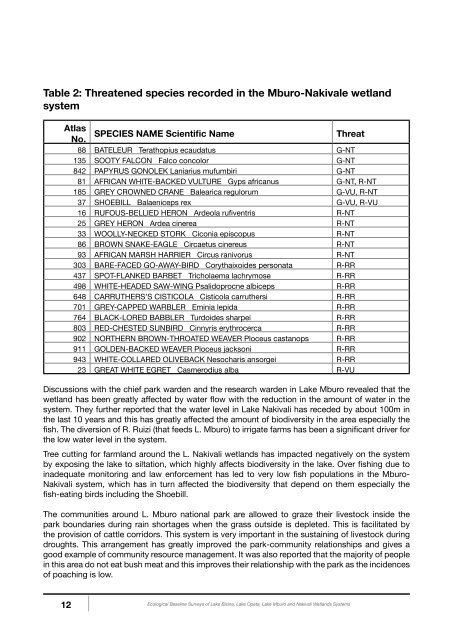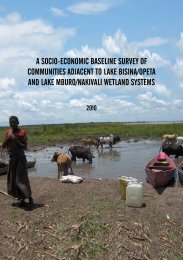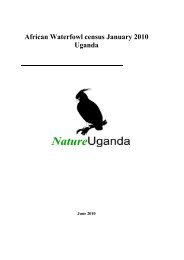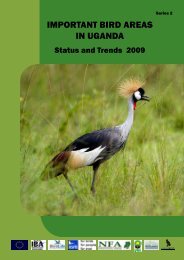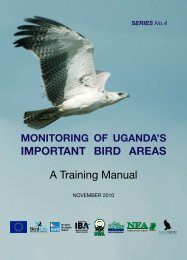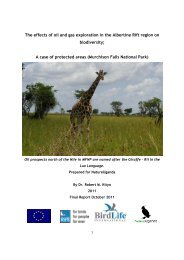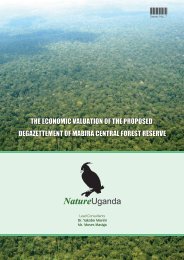A Ecological Baseline Surveys Of: - Lake Bisina - Nature Uganda
A Ecological Baseline Surveys Of: - Lake Bisina - Nature Uganda
A Ecological Baseline Surveys Of: - Lake Bisina - Nature Uganda
You also want an ePaper? Increase the reach of your titles
YUMPU automatically turns print PDFs into web optimized ePapers that Google loves.
Table 2: Threatened species recorded in the Mburo-Nakivale wetland<br />
system<br />
Atlas<br />
No.<br />
SPECIES NAME Scientific Name Threat<br />
88 BATELEUR Terathopius ecaudatus G-NT<br />
135 SOOTY FALCON Falco concolor G-NT<br />
842 PAPYRUS GONOLEK Laniarius mufumbiri G-NT<br />
81 AFRICAN WHITE-BACKED VULTURE Gyps africanus G-NT, R-NT<br />
185 GREY CROWNED CRANE Balearica regulorum G-VU, R-NT<br />
37 SHOEBILL Balaeniceps rex G-VU, R-VU<br />
16 RUFOUS-BELLIED HERON Ardeola rufiventris R-NT<br />
25 GREY HERON Ardea cinerea R-NT<br />
33 WOOLLY-NECKED STORK Ciconia episcopus R-NT<br />
86 BROWN SNAKE-EAGLE Circaetus cinereus R-NT<br />
93 AFRICAN MARSH HARRIER Circus ranivorus R-NT<br />
303 BARE-FACED GO-AWAY-BIRD Corythaixoides personata R-RR<br />
437 SPOT-FLANKED BARBET Tricholaema lachrymose R-RR<br />
498 WHITE-HEADED SAW-WING Psalidoprocne albiceps R-RR<br />
648 CARRUTHERS’S CISTICOLA Cisticola carruthersi R-RR<br />
701 GREY-CAPPED WARBLER Eminia lepida R-RR<br />
764 BLACK-LORED BABBLER Turdoides sharpei R-RR<br />
803 RED-CHESTED SUNBIRD Cinnyris erythrocerca R-RR<br />
902 NORTHERN BROWN-THROATED WEAVER Ploceus castanops R-RR<br />
911 GOLDEN-BACKED WEAVER Ploceus jacksoni R-RR<br />
943 WHITE-COLLARED OLIVEBACK Nesocharis ansorgei R-RR<br />
23 GREAT WHITE EGRET Casmerodius alba R-VU<br />
Discussions with the chief park warden and the research warden in <strong>Lake</strong> Mburo revealed that the<br />
wetland has been greatly affected by water flow with the reduction in the amount of water in the<br />
system. They further reported that the water level in <strong>Lake</strong> Nakivali has receded by about 100m in<br />
the last 10 years and this has greatly affected the amount of biodiversity in the area especially the<br />
fish. The diversion of R. Ruizi (that feeds L. Mburo) to irrigate farms has been a significant driver for<br />
the low water level in the system.<br />
Tree cutting for farmland around the L. Nakivali wetlands has impacted negatively on the system<br />
by exposing the lake to siltation, which highly affects biodiversity in the lake. Over fishing due to<br />
inadequate monitoring and law enforcement has led to very low fish populations in the Mburo-<br />
Nakivali system, which has in turn affected the biodiversity that depend on them especially the<br />
fish-eating birds including the Shoebill.<br />
The communities around L. Mburo national park are allowed to graze their livestock inside the<br />
park boundaries during rain shortages when the grass outside is depleted. This is facilitated by<br />
the provision of cattle corridors. This system is very important in the sustaining of livestock during<br />
droughts. This arrangement has greatly improved the park-community relationships and gives a<br />
good example of community resource management. It was also reported that the majority of people<br />
in this area do not eat bush meat and this improves their relationship with the park as the incidences<br />
of poaching is low.<br />
12<br />
<strong>Ecological</strong> <strong>Baseline</strong> <strong>Surveys</strong> of <strong>Lake</strong> <strong>Bisina</strong>, <strong>Lake</strong> Opeta, <strong>Lake</strong> Mburo and Nakivali Wetlands Systems


